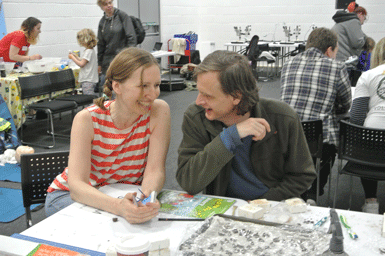 Kate Ogley and Timothy Crowley
Kate Ogley and Timothy Crowley |
Kate Ogley and Timothy Crowley are a collaborative duo based in Cornwall in the U.K and work predominantly with sound.
Their work is often site-specific and explores our connection to place and how memory and identity can be embedded within
the landscape. Their practise encompasses generative, interactive and sometimes multi-disciplinary installations both indoor and out.
They have received commissions from Sound U.K, Falmouth and Exeter University, and residencies in London and Slovakia,
and created ambitious artist led initiatives and innovative sound workshops. Kate Ogley has had films screened at Plymouth University,
Bristol West of England Academy, Cornwall Film Festival and the online Cologne Experimental Documentary Festival.
They are currently working on a series of analogue panoramic photographic installations that also incorporate sound. Each installation
is a re-experiencing of a specific place in Cornwall that they have become familiar with through cycling and wild camping.
They are producing large photographic triptychs which incorporate field recordings within their frames.
Timothy Crowley has adapted and is developing a little known early 20th century technique; refining a speaker system which projects
surround sound from a point behind the frame of the panoramic photograph. Thus allowing the 'viewer' a more immersive experience of the
soundscape and imparting a sense of moving within the landscape.
In 2019 they were selected for a commission by Sound U.K. working with people with mental health issues in Bude Cornwall.
The generative and interactive sound installation Swirl imagines the sea itself as a repository for stories for those who live beside it.
In 2018 they were given a commission to create a community based, ecological and historical project for Falmouth University
that celebrated the founding of the Medieval Glasney College in Penryn. Local people as well as staff and Students from Falmouth University
made clay bees from press moulds that became part of an outdoor gold swarm sculpture located in a willow tree on the University campus.
They have worked with diverse communities including those living on either side of the Maria Valeria Bridge that spans the Danube at Storovo
in Slovakia and Esztergom in Hungary (a contested border). Their projects have engaged with migrant workers, people living with mental health issues,
university students, staff, the general public, musicians and people with profound learning difficulties.